Testkube Agents
A Testkube Environment can contain any number of Agents to perform specific tasks. Agents are added to an Environment via the Dashboard (see below) and then deployed into their target cluster/namespace using either the provided CLI or Helm commands.
Agent Types
There are currently 3 types of Agents available:
- Runner Agents - are deployed to any cluster/namespace where you want to run Workflows created in the Environment
- Listener Agents - are deployed to any cluster/namespace where you want to listen for Kubernetes Event Triggers
- The Standalone Agent - every Testkube Environment currently requires one (and one only) Standalone Agent - Read More
Runner Agents
Runner Agents allow you to run your Workflows wherever you deploy them. You can have any number of Runner Agents in an Environment, allowing you to
- Run the same Workflow in multiple namespaces/clusters, (possibly at the same time!).
- Add ephemeral Runner Agents (deployed in ephemeral infrastructure) to an Environment and run your Test Workflows on them - Read More.
Use-cases for this are:
- Execute the same set of tests across production, staging, or testing environments to ensure consistent test execution.
- Execute the same set of tests in geographically dispersed environments to ensure consistent application behavior.
- Execute tests in local sandbox environments during development while having access to the centralized catalog of tests.
- Execute tests from multiple geographical locations against a (single) environment for realistic performance and e2e testing.
- Execute tests in ephemeral environments created during CI/CD pipelines for testing and deployment purposes - Read More.
Read More about how to run Workflows on Runner Agents at Running Test Workflows.
The Standalone Agent always doubles as a Runner Agent also, see below.
Runner Agents require a license to run Workflows - Read More.
Listener Agents
Listener Agents are created and deployed to clusters/namespaces where you want to listen for Kubernetes Events to trigger Test Triggers.
Use-cases for deploying Listener Agents:
- Listening to application changes in a cluster(s) managed by a GitOps tool to trigger tests when the cluster state is updated.
- Listening to infrastructure changes in a cluster(s) to ensure that validation tests are run whenever a cluster is updated.
Having multiple/separate Listener Agents from Runner Agents allows you to listen for changes in clusters separate from where you might want to run your tests, for example, if tests need to run from outside a cluster to validation connectivity or network performance, you could listen for events using a Listener Agent in cluster A, which would trigger the execution of Workflow on a Runner Agent deployed in cluster B.
The Standalone Agent doubles as a Listener Agent also, but as opposed to the Standalone Agent, which listens for events in all namespaces by default, Listener Agents only listen for events in the namespace they are deployed in.
Read more about how TestTriggers map to Listener Agents at Listener Agents with TestTriggers.
The Standalone Agent
Each Testkube Environment always requires a single Standalone Agent which provides core functionality for Triggers, Webhooks, Prometheus metrics, etc.
The Standalone Agent is installed when you create a new Testkube Environment and is shown on the bottom of the list of Agents
with the label runnertype: superagent.
The Standalone Agent always works both as a Listener and Runner Agent in your Environment, read about how it doubles as a Runner Agent at Running Workflows.
The ID is shown in the list of Agents (see below), the Name is the same xxxx prefixed with tkcenv instead.

Managing Agents
Agents are managed in the Agents tab under the Environment Settings:
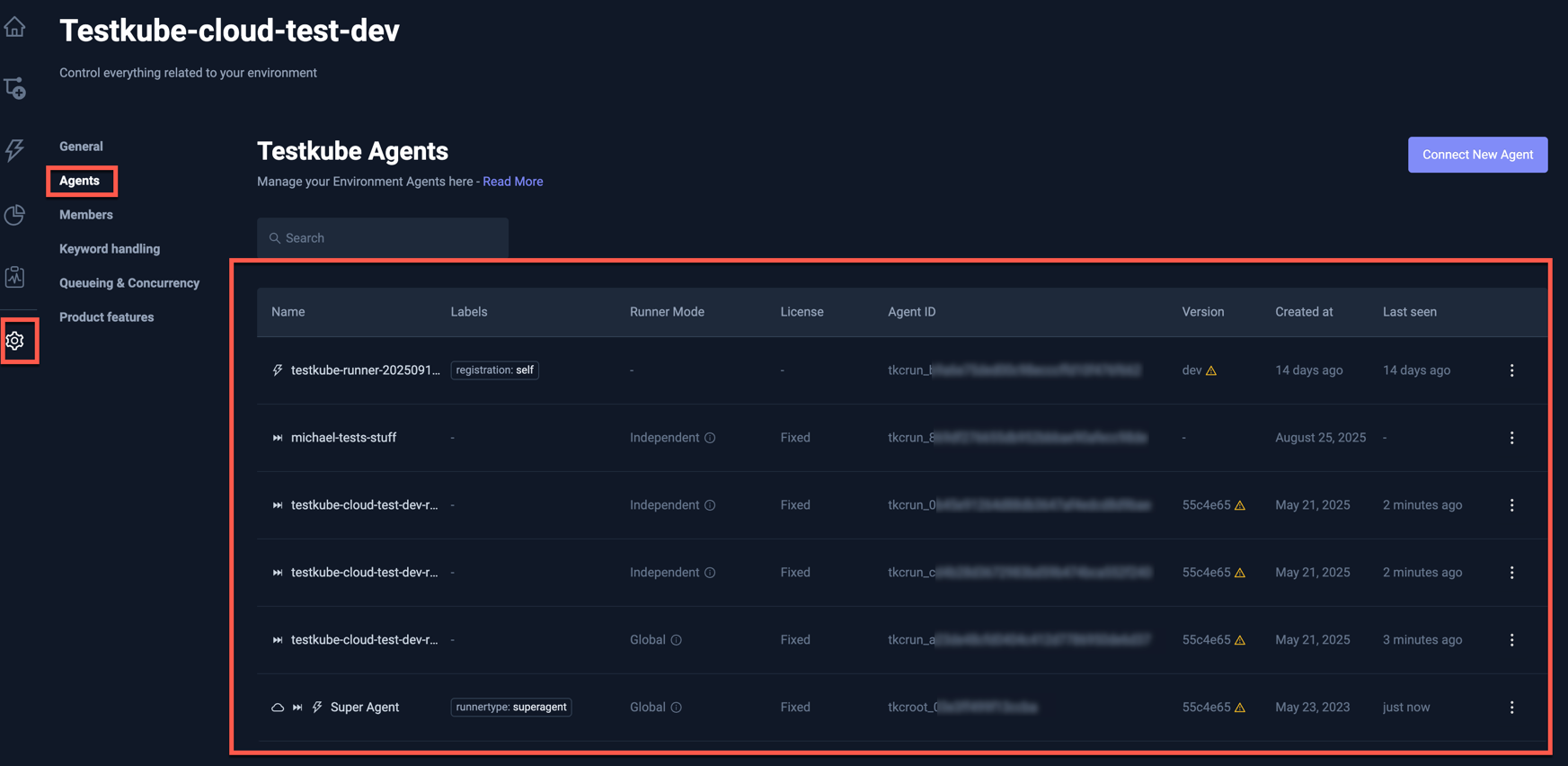
The table has the following columns:
- Name: Capability icons and the name given to the agent on creation.
- Labels: Labels assigned to the Runner Agents on creation - Read More
- Runner Mode: The Runner Mode of the agent if it is a Runner Agent - Read More
- License: The type of license assigned to the Agent if it is a Runner Agent - Read More
- Agent ID: the Agent ID
- Version: The version of the Agent; a warning triangle will be shown if an updated version is available.
- Created at: When the Agent was initially created.
- Last seen: When the Agent was last seen.
Adding Agents to an Environment
Add a new Agent to an Environment by clicking the "Connect New Agent" button, which will open the below dialog:
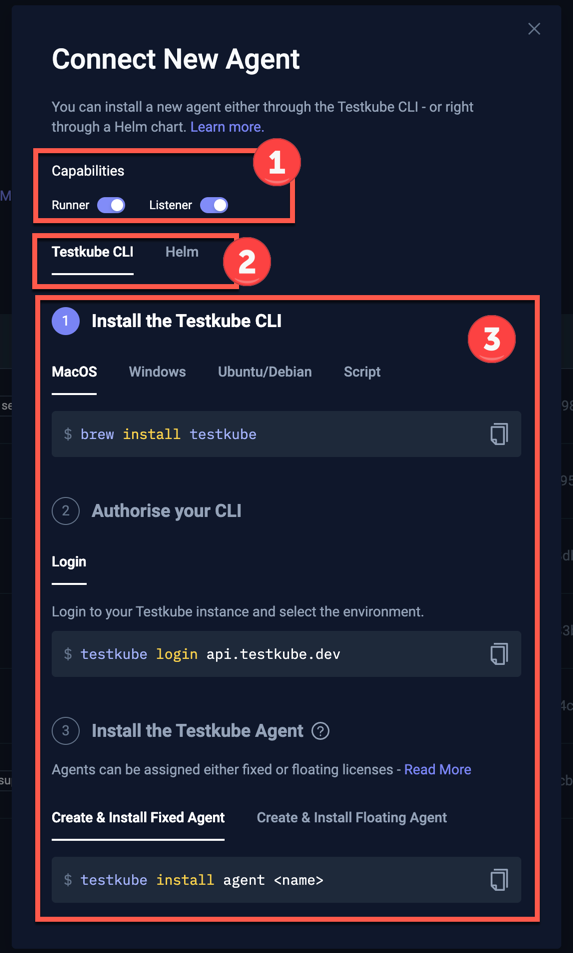
As indicated, there are 3 main choices:
- Which capabilities the Agent should have; Runner, Listener, or both
- If you want to use the Testkube CLI or Helm Chart to install the Agent
- The commands to run to install the Agent with the selected capabilities.
Selecting "Helm" as the tool for installation will show corresponding commands:
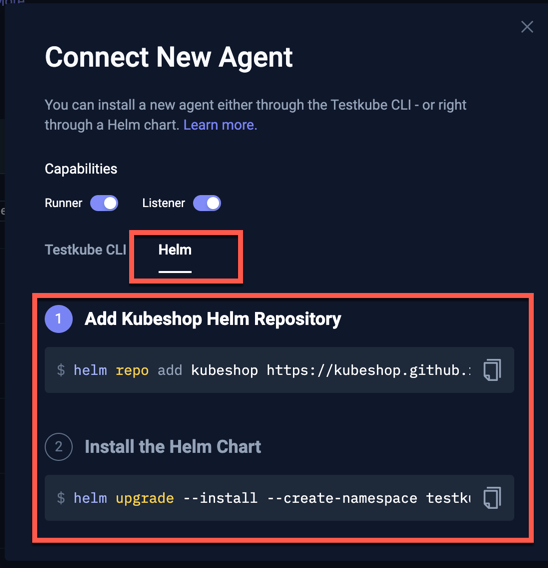
Once the Agent is installed with the select capabilities and tool, it will show up in the list of Agents and is ready for use.
An Agent that has both Runner and Listener capabilities will for all purposes in this documentation be both a Listener Agent and Runner Agent.
Managing an existing Agent
Existing agents are currently managed via the Testkube CLI, use the popup menu to the right in the table to see examples of applicable CLI commands:
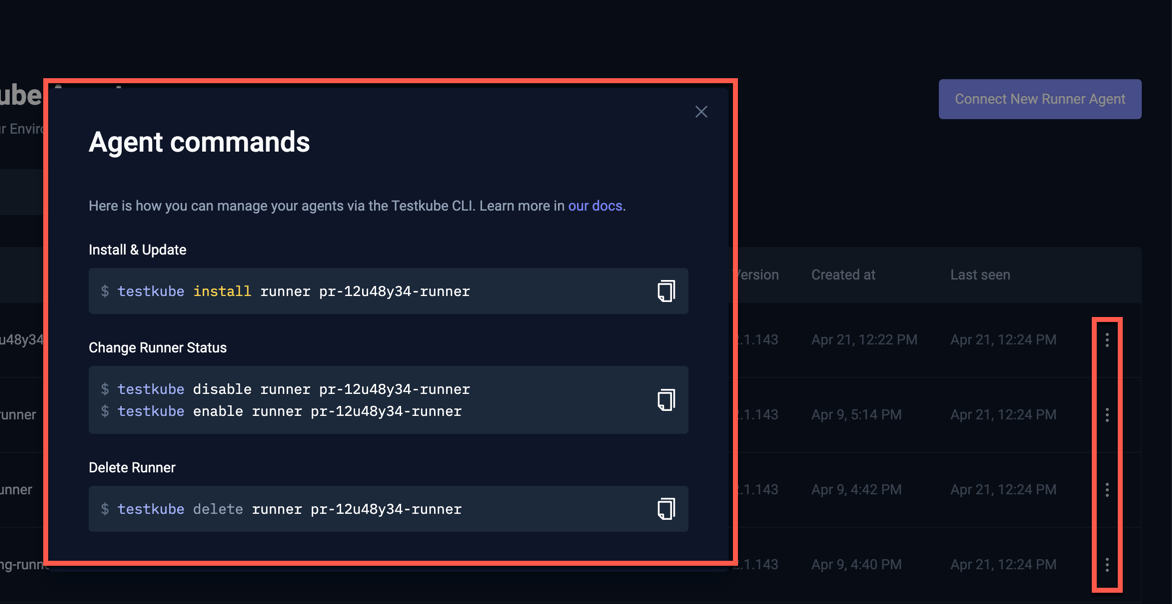
Check out Multi-Agent CLI Overview for an overview of all Testkube CLI commands for working with Testkube Agents, or Runner Helm Chart Overview.
Managing the Standalone Agent
The Standalone Agent shown last in the list has a different set of commands as it is always required. The dialog contains the following information:
- The connection status and name of the agent.
- Which Testkube version the Agent is running, and the latest available version (so you know if an upgrade is available).
- CLI and Helm commands to install or update the Agent to the latest version.
- The
testkube set contextCLI command to configure the Testkube CLI for this agent - Read More.
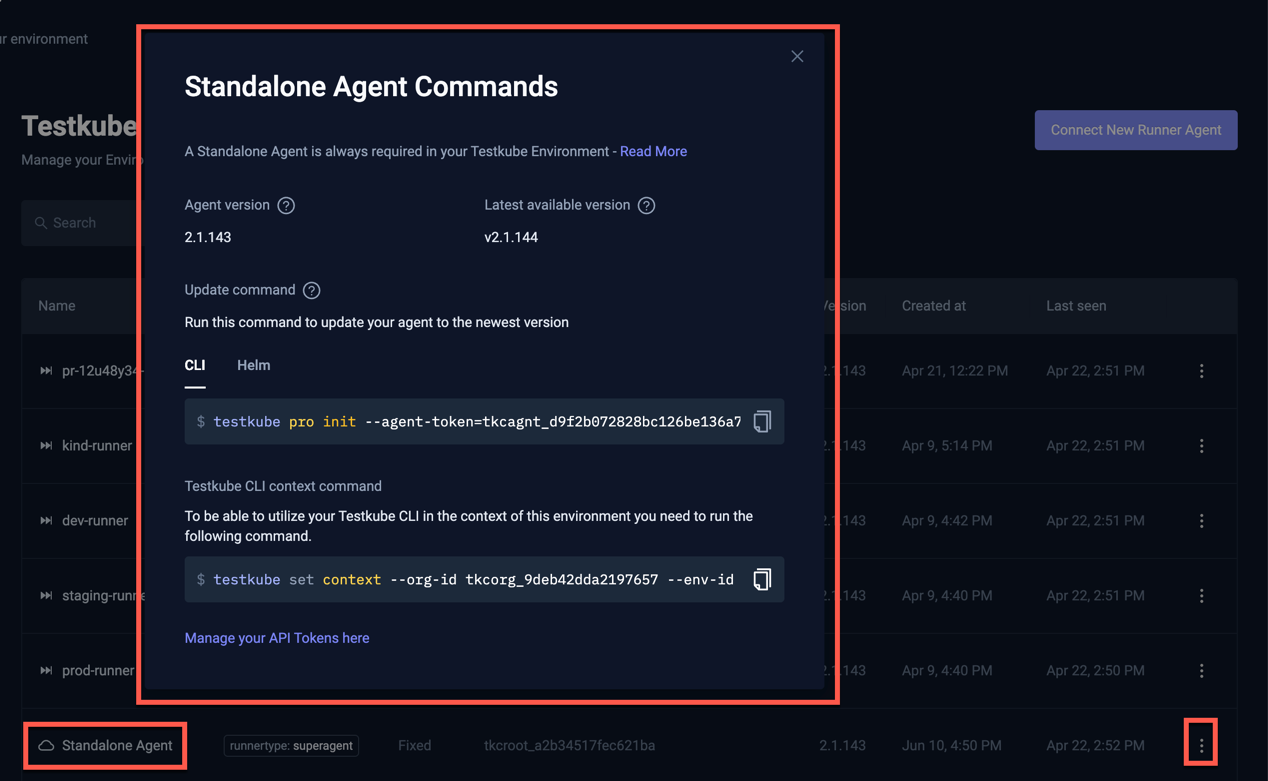
Agent Token Masking
In the “Organization Management” section, under the “Product Features” tab, there is an option called “Agent Token Masking”. When this toggle is enabled, the Testkube Dashboard will no longer display sensitive Runner Agent tokens in the UI.
Important: This masking feature applies only to the Testkube Dashboard UI. Agent tokens or secret keys will still be visible in CLI outputs (e.g., when using testkube create runner or retrieving details for Helm chart installation as described in Installing Runner Agent with Helm Charts) and in any direct API interactions.
Licensing for Runner Agents
Testkube Runner Agents require a license for usage, which can be either Fixed or Floating.
- Runner Agents assigned a Fixed License can always run Workflows independently at any time. The Standalone Agent required for each Testkube Environment always requires a fixed license.
- Runner Agents assigned a Floating license share the ability to execute Workflows concurrently; if one Runner Agent with a floating license is executing a Workflow, a second agent will queue Workflow executions until the first agent is complete. If you, for example, purchase two floating licenses and assign those to 10 agents, two of those agents will be able to execute Workflows concurrently at any give time.
Floating licenses are useful for automated and/or ephemeral use-cases where you don't know in advance how many Runner Agents you will have at any given point in time, and/or you don’t mind if your Workflow executions get queued.
Listener Agents do not require a license, you can have as many Listener Agents deployed in your infrastructure as needed.
Assigning Licenses to Runner Agents
Runner Agents are by default assigned a fixed license (as in all the examples above), use the --floating argument with Runner Agent
creation commands to instead assign a floating license, for example:
# install temporary Runner Agent using a floating license
$ testkube install agent pr-12u48y34-runner --runner --create --floating
The Runner Agent will be shown with the License Type "Floating" in the list of Agents:

Runner Agent License Enforcement
The Runner Agent limit for both Fixed and Floating Licenses is counted and enforced at the organization level, i.e., across all your environments. Furthermore:
- The Standalone Agent required for each Environment will always be assigned a Fixed license.
- You will only be able to create as many fixed Runner Agents as you have Fixed licenses in your Testkube plan.
- You will need to have at least one Floating license in your Testkube plan to be able to create Runner Agents with the
--floatingargument.
Please don't hesitate to Get in Touch if you have any questions/concerns about licensing.
Migrating existing Environments
If you have an existing Environment created before the Multi-Agent functionality was introduced in Q2 2025, and that Environment already has Workflows being executed by CI/CD, CronJobs, Kubernetes Event Triggers, etc., these will continue to be executed on any Global Runner Agent (including the required Standalone Agent) connected to your Environment unless you update the corresponding triggering commands/configuration to target a specific Runner Agent, either by name, group or label - Read More.
Existing Environments that do not make the use of Runner Agents will continue to work as before, it is only when you start adding additional Runner Agents that you might need to adjust how your existing Workflows are triggered by external sources.